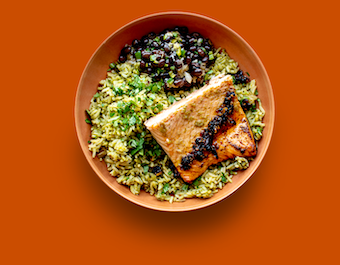Do spicy foods really help you lose weight? How bad are those late-night popcorn parties? And when it comes to filling your plate, should you be more wary of fat or carbs? Sifting through nutrition advice isn’t just overwhelming — it can often be contradictory, as every Instagram star, cookbook author, and online blogger seems to have a hot tip for fueling your body well. To separate fact from fiction, we skipped the fads and turned to nutrition experts and some of the most recent studies. Chow down on these truths:
Myth 1: To lose fat, you gotta go low-fat
Reality check: No one food group is the root of all evil — and scientists are still debating whether low-fat or low-carb produces the most significant weight loss. In a study in the journal Annals of Internal Medicine, people who cut carbs for a year lost significantly more weight and fat than those on a low-fat diet. But in a separate clinical study, in the journal Cell Metabolism, the low-fat diet trumped the low-carb diet when it came to fat loss. For most people, either extreme will be hard to sustain, says Paulette Lambert, RD, director of nutrition at the California Health & Longevity Institute. “The No. 1 risk for diet failure is doing radical, short-term changes,” she says.
What really works: Lambert suggests taking a cue from the so-called Blue Zones — those populations worldwide with the greatest longevity. “Those areas have much better health, and they mainly consume moderate protein, controlled amounts of quality carbs and about 30 to 35 percent from healthy fats,” she says. Healthy fats are the mono- and polyunsaturated kinds found in things like nuts, avocados, and fish — not the saturated and trans fats you’ll get with foods like butter, cream cheese, red meat, and baked goods. Most of us have no idea what percent of our diet is fat, so ditch the extremes and focus on balance and quality instead.
Myth 2: A detox is a good way to reset your body
Reality check: Step away from the juice press. Most people don’t need any help eliminating waste (your GI tract does that just fine, thanks). And most detoxes or juice cleanses are similar to a crash diet, says Lambert, depriving your body of the nutrients and calories it needs. While a few days of a liquid diet probably won’t do long-term damage to your health, research suggests that low-calorie diets can increase your stress hormones, and may alter your body’s balance of hunger and satiety hormones even after you return to eating normally.
What really works: If you love a green smoothie as a portable way to get more kale in your diet, have at it. You’ll get more fiber (and feel fuller longer) if you opt for smoothies over pressed juices, points out Lambert, and keep in mind that even 8 ounces of juice can pack a whopping 25 grams of sugar. Adding milk yogurt (including non-dairy versions), or nut butter to a fiber-filled smoothie will give you a protein boost as well. But in general, smoothies should be just one part of your varied, balanced diet — not the whole thing.
Myth 3: Low-sugar, low-fat desserts are a sweet tooth’s savior
Reality check: It’s true that not all desserts are created equal: A single slice of pecan pie can set you back more than 500 calories and has twice as much fat as a slice of pumpkin pie, which clocks in closer to 300 calories. But here’s the thing: Most of us are not dessert-eating robots, equally satisfied with whatever sweet input graces our lips. “If you always pick the lesser evil or what you should be eating, you’ll wind up not being satisfied and are more likely to keep eating,” says Marissa Lippert, RDN, founder of Nourish Kitchen and author of The Cheater’s Diet.
What really works: “When enjoying dessert, pick something you’re really craving and then don’t go crazy with the portion size,” says Lippert. A few bites of your beloved pecan pie is a better bet than a reluctant slice of pumpkin, followed by seconds. But if all the options look equally good, pick the fruitiest option. “Desserts made with fruit tend to have fewer calories and less sugar than something made with just flour,” she says. “And the fruit offers some fiber as well.” Sweet!
Myth 4: Spicy foods will supercharge your metabolism
Reality check: Capsaicin — the compound that gives chili peppers their powerful kick — has been shown to give the metabolism a small, temporary boost. But before you go sprinkling chili flakes on that platter of queso fundido, consider this: “Chili flakes alone won’t end obesity,” says Liz Applegate, PhD, director of sports nutrition at the University of California, Davis. “If you enjoy spicy foods, there’s no harm in adding some spice, but you also have to do other things that will help you burn calories.”
What really works: Scheduling standing breaks at your desk, going for a stroll during your lunch hour, and taking the stairs rather than the elevator can all burn more calories than testing your taste buds with the spiciest heat you can find. And what’s more, activity builds lean muscle mass, which means you’ll increase your resting metabolic rate long-term (something chili peppers can’t do). Focus on working more activity into your diet, not how much capsaicin you pack into each meal, says Applegate. “And if you can’t tolerate spicy foods, don’t feel bad about skipping it.”
Myth 5: Eating after 7 pm causes weight gain
Reality check: For most people, post-dinner noshing is a nutrition no-no because of what they eat, not when, says Lambert. (When’s the last time you reached for a late-night apple?) And research shows that whether you’re eating dinner at 6 pm or 9 pm may matter less than how many hours you eat in a day: In one animal study, mice that were allowed to eat whenever they wanted gained more weight and had more health issues than mice that ate during a 12-hour window, even though the caloric intake between the two groups was the same. So if you eat breakfast around 8 am, you might want to consider closing the kitchen around 8 pm. But if you’re genuinely hungry after dinner, there’s nothing wrong with a (healthy!) snack, says Lambert — no matter what hour it is.
What really works: If your willpower tends to dip with the sun, go ahead and put the kibosh on post-dinner munchies. But there’s nothing magical about the 7 o’clock mark, says Lambert. One other thing to note: If you’re snacking when you should be sleeping, it might be worth doubling down on an earlier bedtime. A study in the journal Sleep Medicine found that when lab subjects slept just four hours per night for six nights, the rate at which their bodies processed calories from glucose dropped 40 percent. And sleep deprivation may blunt the brain’s ability to regulate appetite, which means a pulling a late night may trigger a ravenous morning.





